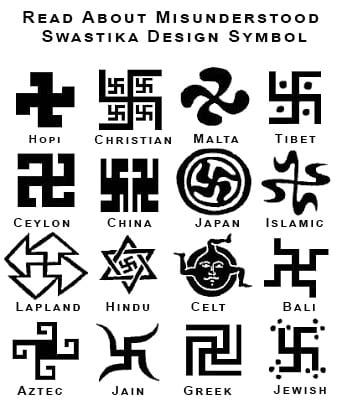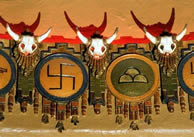The swastika didnt originate with Native Americans. To the Navajo clan the Swastika symbol represents the whirling log.
Is The Swastika A Native American Symbol If So Why Quora
Only the Nazis turned it into a symbol for evil 90 years ago.

Native american swastika. Since World War II the swastika has become stigmatized as a symbol of hatred and racial bias. Which is a sacred image that representsa legend used in healing rituals In fact in other parts of the world the Swastika has been found to predate many other more popular symbols. In response to a complaint about the tiles The president of the university sent a letter to the student which explained the history of the symbol and the context in.
The swastika was a widely used Native American symbol. The swastika is a widely despised symbol that instills fear and terror. This is a nod to both creation and death.
To Native American Indians the swastika is a symbol of the sun the four directions and the four seasons. For the first 15 years of its existence members of the 45th Infantry Division proudly wore on their left shoulders an ancient American Indian symbol of good luck most commonly referred to as the swastika. Native American Symbol Whirling Log Swastika Posted on June 10 2010by Native American Jewelry Tips.
Moreover across the Atlantic Ocean in the Americas the swastika symbol has been constant in many Native American tribes serving as a significant symbol of divinity the afterlife and creation. The swastika has been used by different and completely unrelated cultures around the globe for thousands of years. In the Western world it was a symbol of auspiciousness and good luck until the 1930s when the right-facing tilted.
Native American Version of the Swastika Symbol. Europe Swastikas are more rare in Europe but they are widespread throughout the continent. The swastika symbol 卐 right-facing or clockwise or 卍 left-facing counterclockwise or sauwastika is an ancient religious icon in the cultures of EurasiaIt is used as a symbol of divinity and spirituality in Indian religions including Hinduism Buddhism and Jainism.
Originally it probably symbolized the sun circling through the sky although many other explanations have also been offered. This is an artistic rendition of swastika symbol from the Native American Ho-Chąąnk people also known as Winnebago tribe. It is also a sacred centuries-old symbol found in the Hindu and Buddhist religions and American Indian culture.
Used in Judaism Christianity Islam Buddhism Jainism Tibet China Japan Greece Aztec Ceylon Hopi Celt Bali Malta Lapland etc. Ancient Indian artifacts once owned by Aryan nomads were found to frequently feature the swastika and the symbol was co-opted from its ambiguous historical context in the region to exert the dominance of the so-called Aryan heritage. Copper bookends by Morris Robinson Hopi.
It was used by many southwestern tribes most notably the Navajo. Some of the works in the exhibition featured the swastika symbol which Leyba has worked with for over thirty years to reclaim its original significance in Native American culture. Four birds in a four angled design have been located on Ho-Chąąnk burial grounds.
Everywhere else it has been some sort of auspicious symb. The exhibition contained works by one of its residents Steven Leyba an artist of Native American and Jewish descent. The swastika design indicates they were made before 1940.
The design of the Whirling Logs is similar in appearance to the symbol of horror associated with the Nazis. A Native American chief donning a traditional headresss with the right-facing swastikas. The Nazi use of the swastika stems from the work of 19th Century German scholars translating old Indian texts who noticed similarities between their own language and Sanskrit.
To the ancientHopiof North America the Swastikarepresents the wandering Hopi clan. The symbol was widespread throughout the ancient world particularly in India where it remains in common use by Hindus Jains and Buddhists. The School of Public Health-Bloomington Building at Indiana University contains decorative Native American-inspired swastika tilework on the walls of the foyer and stairwells on the southeast side of the building.
Among different tribes the swastika carried various meanings. The insignia served as recognition of the great number of. Swastika is Sanskrit meaning well-being.
The third image depicts the full image of the Feathered Serpent symbol where the right angles are depicted as gentle curves and the entire symbol is slightly slanted. I know antiques and I knew exactly what it was when I saw it Michael Sanders who organized the flea market told the Salt Lake Tribune a Native blanket with a rolling-log motif The. One of the most popular designs incorporated into American Indian art during the tourist era approximately 1890 to 1940was the swastika symbol common to most indigenous peoples the world over and used throughout time.
The swastika shows up in the artwork of multiple Native American tribes and it has a variety of meanings between tribes. Whirling Log of Native Americans is Swastika October 25 2016 Whirling Log symbol of Native American tribe Navajo is Vedic Swastika 卐.
 The Good Swastika Linking Native Americans And Phoenicians Bofm Blog
The Good Swastika Linking Native Americans And Phoenicians Bofm Blog
Changing Symbols And The Swastika Culture On The Edge
 Unapologetically Indigenous Photo Of The Navajos Banning The Swastika The
Unapologetically Indigenous Photo Of The Navajos Banning The Swastika The
/Swastika-58f7d2263df78ca1598a0901.jpg) Learn The History Of The Swastika
Learn The History Of The Swastika
 The Swastika Motif Its Use In Navajo And Oriental Weaving Dennis J Aigner 9780970189851 Amazon Com Books
The Swastika Motif Its Use In Navajo And Oriental Weaving Dennis J Aigner 9780970189851 Amazon Com Books
 The Swastika Symbol Beyond Redemption Heller Steven 9781581155075 Amazon Com Books
The Swastika Symbol Beyond Redemption Heller Steven 9781581155075 Amazon Com Books
 Swastika Design Antique Rugs And History Of The Swastika Symbol
Swastika Design Antique Rugs And History Of The Swastika Symbol
 Swastika Day Organizers Point To Symbol S Native Origins Indian Country Today
Swastika Day Organizers Point To Symbol S Native Origins Indian Country Today
 Pin On Chiefs Indians From All Over The World
Pin On Chiefs Indians From All Over The World
 Western Use Of The Swastika In The Early 20th Century Wikipedia
Western Use Of The Swastika In The Early 20th Century Wikipedia
 77 Navajo Jewelry Ideer Boho Chic Outfits Smycken Turkos Smycken
77 Navajo Jewelry Ideer Boho Chic Outfits Smycken Turkos Smycken


No comments:
Post a Comment
Note: Only a member of this blog may post a comment.